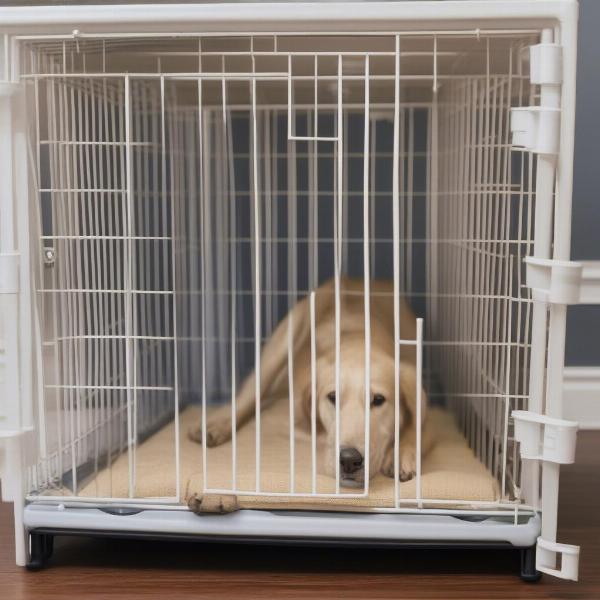Dog cages and pens are essential tools for dog owners, providing a safe and secure space for your furry friend. Whether you’re using a cage for potty training, creating a den-like haven, or ensuring your dog’s safety during travel, selecting the right cage or pen is crucial for your dog’s well-being. This guide will help you navigate the various options, factors to consider, and tips for making your dog’s cage or pen a comfortable and positive experience.
Choosing the right dog cage or pen depends on a number of factors, including your dog’s size, breed, age, and temperament. A crate that’s too small can be restrictive and uncomfortable, while one that’s too large can defeat the purpose of house training or providing a sense of security. Consider your dog’s adult size when choosing a cage, especially for puppies. Additionally, the intended use of the cage or pen – whether for short-term confinement, travel, or as a permanent den – will also influence your decision.
Types of Dog Cages and Pens
Understanding the different types of dog cages and pens available is the first step in making an informed decision. There are several options to choose from, each with its own advantages and disadvantages.
Wire Cages
Wire cages are a popular choice due to their affordability, durability, and excellent ventilation. They allow your dog to see their surroundings, promoting a sense of security and reducing anxiety. Wire cages are also easy to clean and fold flat for storage.
 Wire Dog Cage
Wire Dog Cage
Plastic Cages
Plastic cages, also known as travel kennels, offer more privacy and security, which can be beneficial for anxious or shy dogs. They are also lightweight and easy to transport, making them ideal for travel. However, they can be less durable than wire cages and offer less ventilation.
Soft-Sided Cages
Soft-sided cages are lightweight, portable, and easy to set up. They are a good option for travel or temporary confinement. However, they are not as durable as wire or plastic cages and are not suitable for dogs who chew or dig.
Dog Pens
Dog pens provide a larger enclosed area for your dog to roam and play, offering more freedom than a traditional cage. They can be used indoors or outdoors and are a good option for puppies or dogs who need more space.
Choosing the Right Size
Selecting the correct size cage is paramount for your dog’s comfort. The cage should be large enough for your dog to stand up, turn around, and lie down comfortably. A cage that is too small can be restrictive and stressful, while one that is too large can defeat the purpose of house training.
Measuring Your Dog
To determine the appropriate cage size, measure your dog from nose to tail and from the top of their head to the ground (while standing). Add a few inches to each measurement to ensure adequate space.
Creating a Comfortable Environment
Once you’ve chosen the right cage or pen, it’s essential to create a comfortable and inviting space for your dog. A soft bed, a few toys, and a water bowl will make the cage feel more like home. You can also cover the cage with a blanket to create a den-like atmosphere, especially for anxious dogs.
Training Your Dog to Use a Cage
Introducing your dog to their cage should be a gradual and positive process. Start by associating the cage with positive experiences, such as treats and toys. Never force your dog into the cage, as this can create negative associations. With patience and consistency, your dog will learn to view their cage as a safe and comfortable space.
Conclusion
Dog cages and pens are valuable tools for dog owners, offering a range of benefits from potty training to travel safety. By understanding the different types available, choosing the correct size, and creating a comfortable environment, you can ensure your dog’s cage or pen is a positive and enriching experience. Remember, a well-chosen and properly utilized cage can become a cherished haven for your furry companion.
FAQ
- How do I choose the right size cage for my puppy? Consider their adult size. It’s better to get a larger cage and use a divider to adjust the space as they grow.
- Can I leave my dog in a cage all day? No, dogs need regular exercise and interaction. Cages should be used for short periods, not as a replacement for attention.
- What’s the best way to clean a dog cage? Remove bedding and wash it regularly. Clean the cage itself with soap and water, ensuring it’s thoroughly dry before your dog returns.
- How do I introduce my dog to a cage? Make it positive! Use treats, toys, and praise. Never force them inside.
- Are dog pens a good alternative to cages? Pens offer more space, but cages provide a more secure and den-like environment. The best choice depends on your dog’s individual needs.
- What should I put in my dog’s cage? A comfortable bed, fresh water, and a few safe toys.
- Can I use a cage for potty training? Yes, cages can be helpful for potty training, but they should be used correctly and in conjunction with consistent training methods.
Related Articles on ILM Dog:
About ILM Dog:
ILM Dog is your trusted global resource for expert advice on dog care and breeding. We offer comprehensive guides on breed selection, health, training, nutrition, grooming, and much more, catering to both novice and experienced dog owners. Whether you need help choosing the perfect breed or advice on senior dog care, ILM Dog provides the information you need. Contact us at [email protected] or +44 20-3965-8624 for personalized guidance.